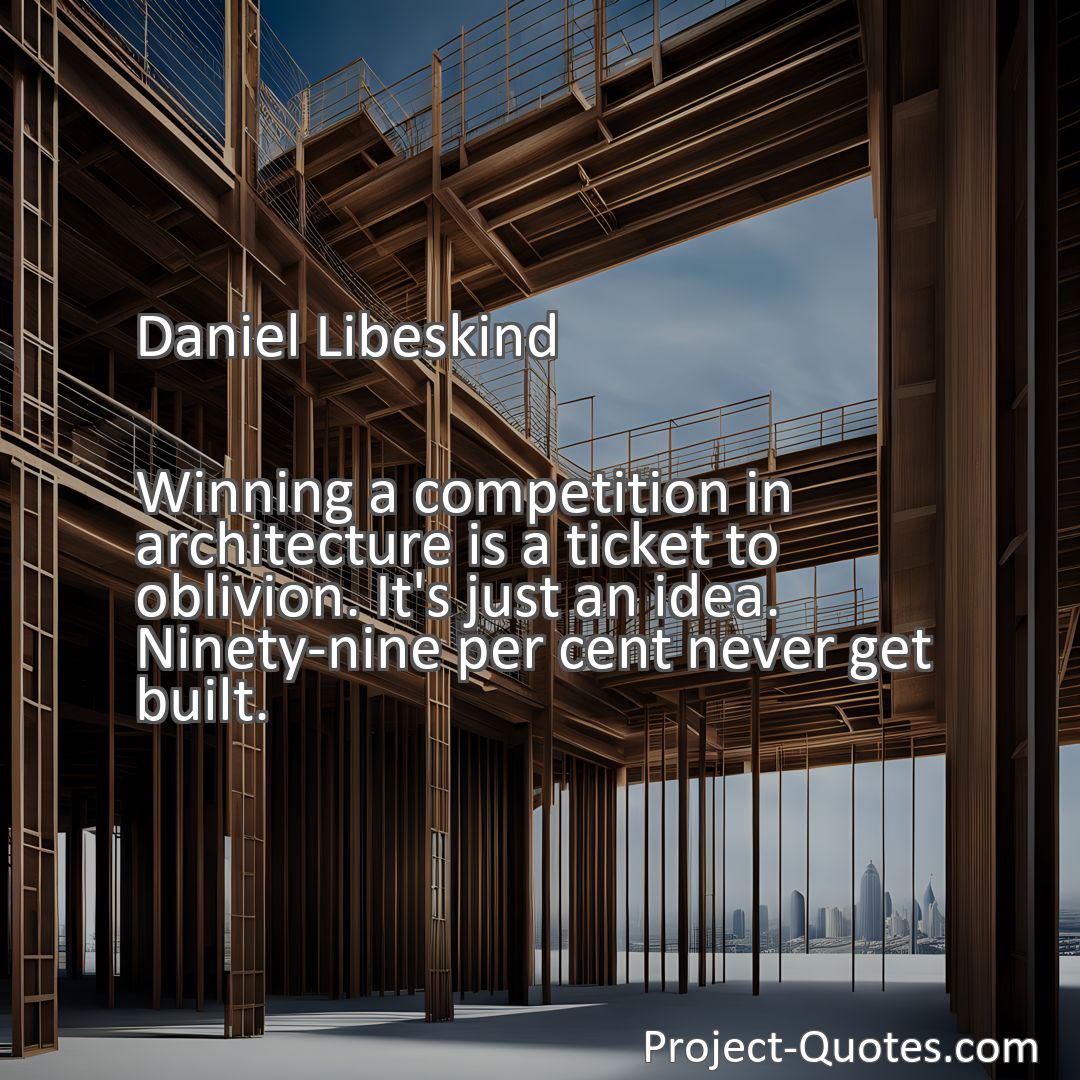Winning a competition in architecture is a ticket to oblivion. It’s just an idea. Ninety-nine per cent never get built.
Daniel Libeskind
Why Architectural Competitions Hold Weight: Exploring the Truth Behind the 99 Percent of Designs that Never Get Built While winning an architectural competition doesn’t guarantee the construction of a design, aspiring architects should still embrace and participate in competitions. Despite the low percentage of built designs, competitions serve as catalysts for progress, fostering creativity, innovation, and collaboration within the architectural community. Participating in competitions nurtures talent, builds resilience, and contributes to the ongoing evolution of the discipline.
Table of Contents
- 1 Winning a competition in architecture is a ticket to oblivion. It’s just an idea. Ninety-nine per cent never get built.
- 2 Daniel Libeskind
- 3 Meaning of Quote – Winning a competition in architecture is a ticket to oblivion. It’s just an idea. Ninety-nine per cent never get built.
- 4 Freely Shareable Quote Image
- 5 Related
Meaning of Quote – Winning a competition in architecture is a ticket to oblivion. It’s just an idea. Ninety-nine per cent never get built.
Have you ever dreamed of winning a competition and being recognized for your brilliant architectural ideas? Imagine the sense of accomplishment and validation that comes with creating a masterpiece that will shape the world around us. Aspiring architects often see competitions as their ticket to success, a way to showcase their innovative designs and gain recognition in the field. However, acclaimed architect Daniel Libeskind challenges this widely held belief, stating, “Winning a competition in architecture is a ticket to oblivion. It’s just an idea. Ninety-nine percent never get built.”
At first, Libeskind’s words may seem discouraging, but upon closer examination, they reveal a deeper truth about the nature of architectural competitions and the challenges faced by aspiring architects. Let’s explore the idea behind this quote and why it holds weight in the architectural world.
To truly understand Libeskind’s perspective, it’s important to consider the vast number of ideas that are generated during architectural competitions. These competitions attract talented architects from around the globe, all seeking to leave their mark on the world. The sheer volume of entries means that only a small fraction of them will ever come to fruition. This daunting reality highlights the inherent risk and uncertainty associated with competitions.
Another factor that contributes to the low percentage of built designs is the complex process involved in turning an idea into a tangible structure. Architecture is not solely about imagination and creativity; it is a delicate balance between artistic vision, engineering expertise, financial viability, and functional requirements. Many winning designs fail to meet one or more of these criteria when scrutinized in the real-world context, leading to their demise before construction even begins.
Additionally, architectural competitions often prioritize visual impact and originality over practicality and cost-effectiveness. While this may result in stunning and groundbreaking designs, it also increases the chances of an idea remaining unrealized. Budget constraints, construction limitations, and the need to adhere to local building regulations can all hinder the translation of a visionary design into a solid structure.
Furthermore, the competition itself can be a double-edged sword. Winning an architectural competition doesn’t guarantee that a project will move forward, as it depends on various external factors such as funding availability, political support, and societal needs. The triumph one experiences upon winning a competition can quickly turn into frustration when faced with the realities of bringing the idea to life.
However, despite the odds, it is crucial to acknowledge the significance of architectural competitions in advancing the field. Competitions serve as a platform for architects to push boundaries, explore innovative solutions, and engage in a fruitful exchange of ideas. Even if a design doesn’t materialize, it can spark inspiration for future projects and pave the way for groundbreaking developments.
Additionally, the process of participating in architectural competitions itself has numerous benefits. It allows architects to fine-tune their design skills, receive constructive feedback from industry experts, collaborate with fellow professionals, and gain visibility within the architectural community. These experiences and connections can open doors to future opportunities and propel an architect’s career forward.
Furthermore, the mere act of competing encourages architects to think outside the box and challenge conventional norms. It fosters an environment of healthy competition, stimulating the collective imagination of the architectural community and encouraging the development of bold new ideas. Without competitions, the architectural world could become stagnant, lacking the influx of fresh perspectives that drive progress and innovation.
So, why should aspiring architects still pursue competitions despite the low success rate in seeing their designs built? While it’s essential to acknowledge the realities highlighted by Libeskind’s quote, it’s equally important to embrace the broader value that competitions offer. Architectural competitions serve as a platform for architects to create, showcase their talent, receive recognition, and contribute to the evolution of the discipline.
Moreover, participating in competitions helps architects cultivate resilience and adaptability, vital qualities for success in an ever-changing field. The ability to persist in the face of setbacks, learn from failures, and refine their designs ultimately strengthens architects’ skills and prepares them for future challenges.
Ultimately, winning an architectural competition should not be the sole measure of success for aspiring architects. It is vital to recognize that even if an idea remains unrealized, its impact can be profound. Groundbreaking designs that never leave the drawing board influence future generations of architects, shaping the collective imagination and inspiring new possibilities.
In conclusion, Daniel Libeskind’s quote challenges the conventional notion that winning a competition is the ultimate goal for architects. While it’s true that a vast majority of competition-winning designs never see the light of day, it is imperative to remember that architectural competitions offer much more than just a chance to build. They serve as catalysts for progress, fostering creativity, innovation, and collaboration within the architectural community. Participating in competitions nurtures talent, builds resilience, and contributes to the ongoing evolution of the discipline. So, aspiring architects, don’t be deterred by the low percentage of built designs; instead, embrace the transformative power of competitions and continue to push the boundaries of architectural imagination.
I hope this quote inspired image brings you hope and peace. Share it with someone who needs it today!


